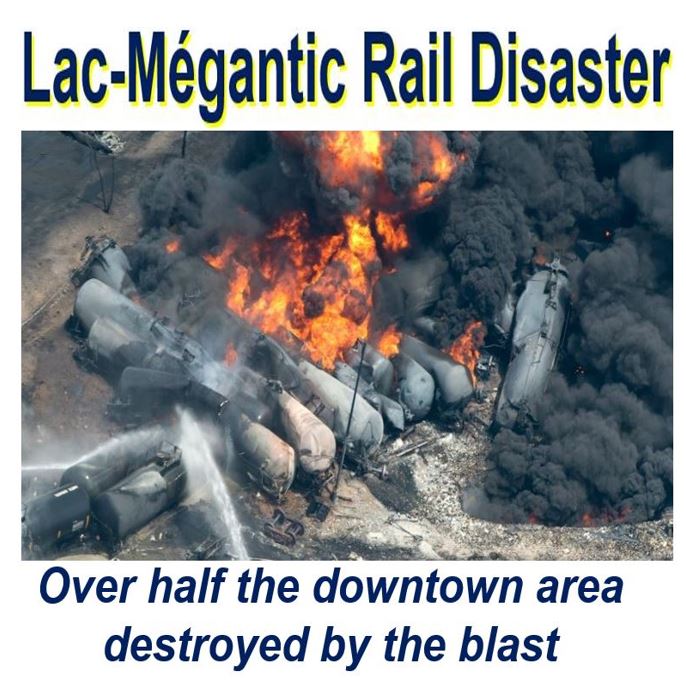The Canadian government is accelerating the implementation of safety measures that were recommended following the Lac-Mégantic rail disaster when an unattended seventy-four-car train carrying crude oil derailed, resulting in a massive fire and explosion of several tank cars and 42 confirmed deaths plus five more humans missing and presumed dead.
The disaster occurred three years ago in the town of Lac-Mégantic, in the Eastern Townships of Quebec. The unattended train cars rolled down a 1.2% gradient and then derailed.
Joseph Jean-Pierre Marc Garneau, Minister of Transport in the Government of Canada, will make the announcement today in Ottawa. As of November 1st, the tank cars will not be allowed to transport crude oil or other dangerous goods on Canada’s railways.
 The temperature in the fire was so high that no trace of five of the humans presumed dead was ever detected. (Image: commondreams.org)
The temperature in the fire was so high that no trace of five of the humans presumed dead was ever detected. (Image: commondreams.org)
Non-jacketed and jacketed cars to stop carrying oil
The plan for ‘non-jacketed’ cars will come into effect six months earlier than planned. Non-jacketed cars are those that do not have a layer of thermal protection. The new regulation will come in 16 months earlier than planned for cars with jackets – their phase-out deadlines had been originally planned for May 2018.
Mr. Garneau’s announcement is scheduled to start at 13:30 ET in Montreal.
The so-called DOT-111 cars do not provide enough protection against fire, and increase the likelihood of explosions, says the Transportation Safety Board.
According to investigator comments, which have been going on for decades, they are easily ruptured or punctured – even during seemingly harmless low-speed collisions.
The Canadian Government has already ordered all DOT-111 cars to cease transporting crude oil on the country’s railway system by spring 2017.
Les wagons mis en cause dans la tragédie de #LacMégantic retirés plus vite que prévu #polcan https://t.co/olwFnRXJTw via @HuffPostQuebec
— Catherine Lévesque (@CathLvesque) July 25, 2016
New safer tank car
In May 2015, a new class of tank car was unveiled. It has a significantly thicker steel hull, a full head shield, thermal protection, a bottom outlet valve, and protective valve covers.
Mr. Garneau said regarding the new class of tank car:
“This type of tank car will be much more able to resist puncture.”
The DOT-11 cars are clearly not safe enough, Mr. Garneau said, and emphasized that for the Federal Transport authorities safety is the number 1 priority.
The amount of oil being transported by rail has increased dramatically over the past few years. In 2015 a total of 146,000 shipments of crude traveled along Canada’s railway tracks.
 Minister of Transport Marc Garneau was the first Canadian astronaut to fly in space. Before becoming a Member of Parliament, he was President of the Canadian Space Agency. (Image: Wikipedia)
Minister of Transport Marc Garneau was the first Canadian astronaut to fly in space. Before becoming a Member of Parliament, he was President of the Canadian Space Agency. (Image: Wikipedia)
Lac-Mégantic rail disaster shocked the world
The extent of devastation during the Lac-Mégantic rail disaster at 01:15 EDT, on July 6, 2013 shocked the world. According to local media reports, the blast radius reached 1 kilometre (0.6 of a mile).
Of all the remaining buildings in the centre of the town, only three are not scheduled for demolition due to petroleum contamination of the townsite.
The death toll makes the rail accident the fourth-deadliest in the country’s history, and the deadliest involving a non-passenger train.
Video – Lac-Mégantic rail disaster
